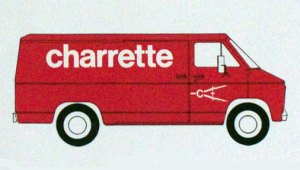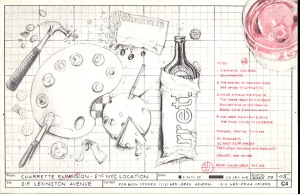
What began as a single article, written by me as the NY Graphic Design Examiner, evolved into a series of articles, seven in total, that spanned a year’s time to complete. Although the time to compile all the materials, including researching, interviewing primary sources and so on did not take a full year, a new assignment as an author for The Digital Brand Marketing Blog took me away from the project for sometime during that year. In fact, this multi-author blog has made it to the semi-finals of the Social Media Examiner’s Top Ten Blogs 2012 competition.
But it was overdue to be completed, as hard as it was to write a Charrette Corporation fond farewell. It was like a long ‘good bye’ that no one wants to make when dear friends must part. But it had to be done. Essentially, I knew what the final article would be about, the store designed by architect, David Paul Helpern, a fellow student of Charrette Corporation founders, Lionel Spiro and Blair Brown, who all attended the Harvard Graduate School of Design. The store, located on Manhattan’s East side on Lexington Avenue in the East 30’s, was the Crowning Jewel of the Charrette NY retail side.
Although the commercial accounts handled by a sales force that covered much of the East Coast and into the Midwest were much larger than the retail side sales, the retail side was the face of the corporation. This gave Charrette the opportunity to show the world the ‘stuff it was made of’. As the tip of the iceberg, it glistened in the sun and shone like a well-polished gem. The flagship store was the ultimate representation of the Charrette brand.
It was a company whose name was synonymous with quality. The tools and supplies manufactured for and sold by Charrette had to be of the highest quality. The pedigree that resulted from employment at the company practically guaranteed future employment anywhere when the time came for someone to move on.
The Charrette corporate culture, philosophy and brand development was such that it is possible that other retail corporations fashioned their stores after Charrette. They were clean looking with simple straight lines, well designed, displaying everyday items as if they were high end designer merchandise.

One article led to another as one primary resource introduced me to the next. Both founders eventually became available and many memorable hours were spent on the phone reminiscing about their beloved company. Supplies, catalogs, photos and other memorabilia were supplied to accompany the memories. One by one, staff, customers and HGSD alumni were located and interviewed.
The generosity of everyone was as real as the quality of the Charrette inventory. The Charrette culture had affected everyone who came in touch with it. The writing of this story took on a life of its own, a life that also had to be written in a way that gave credence to this corporate culture and all its glorious history.
So I wrote and wrote and wrote. When would it end? How would it end? Numerous months’ hiatus from the writing became awkward and the pressure to finish overcame the same lingering feeling of not wanting to say good-bye. But at the same time, it was clear that the final tribute had to be made and how to do it.
That is where The Charrette NY Crowning Jewel came into the picture. It was a store that was written up in two nationally respected professional magazines, Interiors (February 1982) and Visual Merchandising (June 1982), had a grand, grand opening and one that was built to design specifications. It was glorious. Everything about it and in it was a designer’s dream. In addition, the place, their products, and award winning packaging designs were featured in two nationally renowned design magazines, Communication Arts (March/April 1982) and Print (May/June 1982).
And then, in spite of the attempts to keep up with the times of transition from analog to digital design, it was time to let go. No more founders, some staff stayed, some staff went. The era that was the original Charrette was gone. The company was bought by a succession of other companies. It even became known by different names. But the culture and the philosophy could not be packaged, bought and sold.

So it was time to say good-bye, for all of us, the founders, the staff, the customers and even this author of a series of articles that became the Charrette NY Chronicle that took a year to write. It is all over. But much will live on in the minds and memories of those whose lives were touched by the experience of their involvement.
There is a Charrette Alumni Group on Linkedin. I am the only civilian to have the honor of belonging. There is also an Internet photo archive on flickr. Finally and in some small way, it is my sincere hope that the Charrette Chronicle will be part of this legacy. It is dedicated to all the wonderful people who let me into their lives and shared their stories so that I could write a series in honor of them and their Charrette experience. Thank you all. I wish you a fond farewell. You shall never be forgotten, Charrette Corporation.
Related Article Links
Gone But Never Forgotten: An Invitation to a Graphic Memoir
The Baby Was Born In a Harvard Closet
Charrette Meets ‘Big Apple’ Graphic Standards
The Charrette NY Creative Culture
Paul Rand: the NYC born and educated graphic designer, Part One
Part Two: Paul Rand, the NYC born graphic designer
The Charrette NY Chronicle Completed

